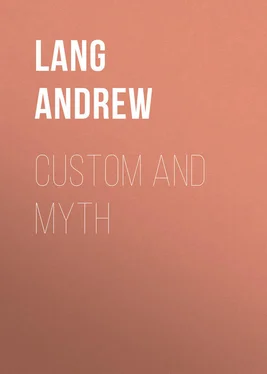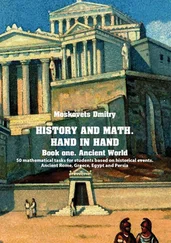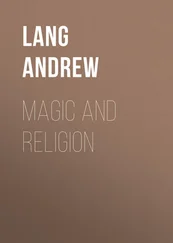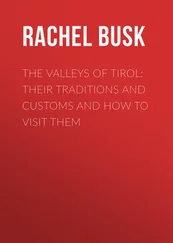Andrew Lang - Custom and Myth
Здесь есть возможность читать онлайн «Andrew Lang - Custom and Myth» — ознакомительный отрывок электронной книги совершенно бесплатно, а после прочтения отрывка купить полную версию. В некоторых случаях можно слушать аудио, скачать через торрент в формате fb2 и присутствует краткое содержание. Жанр: foreign_antique, foreign_prose, на английском языке. Описание произведения, (предисловие) а так же отзывы посетителей доступны на портале библиотеки ЛибКат.
- Название:Custom and Myth
- Автор:
- Жанр:
- Год:неизвестен
- ISBN:нет данных
- Рейтинг книги:3 / 5. Голосов: 1
-
Избранное:Добавить в избранное
- Отзывы:
-
Ваша оценка:
- 60
- 1
- 2
- 3
- 4
- 5
Custom and Myth: краткое содержание, описание и аннотация
Предлагаем к чтению аннотацию, описание, краткое содержание или предисловие (зависит от того, что написал сам автор книги «Custom and Myth»). Если вы не нашли необходимую информацию о книге — напишите в комментариях, мы постараемся отыскать её.
Custom and Myth — читать онлайн ознакомительный отрывок
Ниже представлен текст книги, разбитый по страницам. Система сохранения места последней прочитанной страницы, позволяет с удобством читать онлайн бесплатно книгу «Custom and Myth», без необходимости каждый раз заново искать на чём Вы остановились. Поставьте закладку, и сможете в любой момент перейти на страницу, на которой закончили чтение.
Интервал:
Закладка:
Let us next observe a remarkable peculiarity of the turndun , or Australian bull-roarer. The bull-roarer in England is a toy. In Australia, according to Howitt and Fison, 13 13 Kamilaroi and Kurnai , p. 268.
the bull-roarer is regarded with religious awe. ‘When, on lately meeting with two of the surviving Kurnai, I spoke to them of the turndun, they first looked cautiously round them to see that no one else was looking, and then answered me in undertones.’ The chief peculiarity in connection with the turndun is that women may never look upon it. The Chepara tribe, who call it bribbun , have a custom that, ‘if seen by a woman, or shown by a man to a woman, the punishment to both is death .’
Among the Kurnai, the sacred mystery of the turndun is preserved by a legend, which gives a supernatural sanction to secrecy. When boys go through the mystic ceremony of initiation they are shown turnduns, or bull-roarers, and made to listen to their hideous din. They are then told that, if ever a woman is allowed to see a turndun, the earth will open, and water will cover the globe. The old men point spears at the boy’s eyes, saying: ‘If you tell this to any woman you will die, you will see the ground broken up and like the sea; if you tell this to any woman, or to any child, you will be killed!’ As in Athens, in Syria, and among the Mandans, the deluge-tradition of Australia is connected with the mysteries. In Gippsland there is a tradition of the deluge. ‘Some children of the Kurnai in playing about found a turndun, which they took home to the camp and showed the women. Immediately the earth crumbled away, and it was all water, and the Kurnai were drowned.’
In consequence of all this mummery the Australian women attach great sacredness to the very name of the turndun. They are much less instructed in their own theology than the men of the tribe. One woman believed she had heard Pundjel, the chief supernatural being, descend in a mighty rushing noise, that is, in the sound of the turndun, when boys were being ‘made men,’ or initiated. 14 14 Fison, Journal Anthrop. Soc ., Nov. 1883.
On turnduns the Australian sorcerers can fly up to heaven. Turnduns carved with imitations of water-flowers are used by medicine-men in rain-making. New Zealand also has her bull-roarers; some of them, carved in relief, are in the Christy Museum, and one is engraved here. I have no direct evidence as to the use of these Maori bull-roarers in the Maori mysteries. Their employment, however, may perhaps be provisionally inferred.
One can readily believe that the New Zealand bull-roarer may be whirled by any man who is repeating a Karakia , or ‘charm to raise the wind’: —
Loud wind,
Lasting wind,
Violent whistling wind,
Dig up the calm reposing sky,
Come, come.
In New Zealand 15 15 Taylor’s New Zealand , p. 181.
‘the natives regarded the wind as an indication of the presence of their god,’ a superstition not peculiar to Maori religion. The ‘cold wind’ felt blowing over the hands at spiritualistic séances is also regarded (by psychical researchers) as an indication of the presence of supernatural beings. The windy roaring noise made by the bull-roarer might readily be considered by savages, either as an invitation to a god who should present himself in storm, or as a proof of his being at hand. We have seen that this view was actually taken by an Australian woman. The hymn called ‘breath,’ or haha , a hymn to the mystic wind, is pronounced by Maori priests at the moment of the initiation of young men in the tribal mysteries. It is a mere conjecture, and possibly enough capable of disproof, but we have a suspicion that the use of the mystica vannus Iacchi was a mode of raising a sacred wind analogous to that employed by whirlers of the turndun. 16 16 This is not the view of le Père Lafitau, a learned Jesuit missionary in North America, who wrote (1724) a work on savage manners, compared with the manners of heathen antiquity. Lafitau, who was greatly struck with the resemblances between Greek and Iroquois or Carib initiations, takes Servius’s other explanation of the mystica vannus , ‘an osier vessel containing rural offerings of first fruits.’ This exactly answers, says Lafitau, to the Carib Matoutou , on which they offer sacred cassava cakes.
Servius, the ancient commentator on Virgil, mentions, among other opinions, this – that the vannus was a sieve, and that it symbolised the purifying effect of the mysteries. But it is clear that Servius was only guessing; and he offers other explanations, among them that the vannus was a crate to hold offerings, primitias frugum.
We have studied the bull-roarer in Australia, we have caught a glimpse of it in England. Its existence on the American continent is proved by letters from New Mexico, and by a passage in Mr. Frank Cushing’s ‘Adventures in Zuni.’ 17 17 The Century Magazine, May 1883.
In Zuni, too, among a semi-civilised Indian tribe, or rather a tribe which has left the savage for the barbaric condition, we find the bull-roarer. Here, too, the instrument – a ‘slat,’ Mr. Gushing calls it – is used as a call to the ceremonial observance of the tribal ritual. The Zunis have various ‘orders of a more or less sacred and sacerdotal character.’ Mr. Cushing writes: —
These orders were engaged in their annual ceremonials, of which little was told or shown me; but, at the end of four days, I heard one morning a deep whirring noise. Running out, I saw a procession of three priests of the bow, in plumed helmets and closely-fitting cuirasses, both of thick buckskin – gorgeous and solemn with sacred embroideries and war-paint, begirt with bows, arrows, and war-clubs, and each distinguished by his badge of degree – coming down one of the narrow streets. The principal priest carried in his arms a wooden idol, ferocious in aspect, yet beautiful with its decorations of shell, turquoise, and brilliant paint. It was nearly hidden by symbolic slats and prayer-sticks most elaborately plumed. He was preceded by a guardian with drawn bow and arrows, while another followed, twirling the sounding slat, which had attracted alike my attention and that of hundreds of the Indians, who hurriedly flocked to the roofs of the adjacent houses, or lined the street, bowing their heads in adoration, and scattering sacred prayer-meal on the god and his attendant priests. Slowly they wound their way down the hill, across the river, and off toward the mountain of Thunder. Soon an identical procession followed and took its way toward the western hills. I watched them long until they disappeared, and a few hours afterward there arose from the top of ‘Thunder Mountain’ a dense column of smoke, simultaneously with another from the more distant western mesa of ‘U-ha-na-mi,’ or ‘Mount of the Beloved.’
Then they told me that for four days I must neither touch nor eat flesh or oil of any kind, and for ten days neither throw any refuse from my doors, nor permit a spark to leave my house, for ‘This was the season of the year when the “grandmother of men” (fire) was precious.’
Here then, in Zuni, we have the bull-roarer again, and once more we find it employed as a summons to the mysteries. We do not learn, however, that women in Zuni are forbidden to look upon the bull-roarer. Finally, the South African evidence, which is supplied by letters from a correspondent of Mr. Tylor’s, proves that in South Africa, too, the bull-roarer is employed to call the men to the celebration of secret functions. A minute description of the instrument, and of its magical power to raise a wind, is given in Theal’s ‘Kaffir Folklore,’ p. 209. The bull-roarer has not been made a subject of particular research; very probably later investigations will find it in other parts of the modern world besides America, Africa, New Zealand, and Australia. I have myself been fortunate enough to encounter the bull-roarer on the soil of ancient Greece and in connection with the Dionysiac mysteries. Clemens of Alexandria, and Arnobius, an early Christian father who follows Clemens, describe certain toys of the child Dionysus which were used in the mysteries. Among these are turbines , κωνοι, and ρομβοι. The ordinary dictionaries interpret all these as whipping-tops, adding that ρομβος is sometimes ‘a magic wheel.’ The ancient scholiast on Clemens, however, writes: ‘The κωνος is a little piece of wood, to which a string is fastened, and in the mysteries it is whirled round to make a roaring noise.’ 18 18 Κωνος ξυλαριον ου εξηπται το σπαρτιον και εν ταις τελεταις εδονειτο ινα ροιζη. Lobeck, Aglaophamus (i. p. 700).
Here, in short, we have a brief but complete description of the bull-roarer of the Australian turndun . No single point is omitted. The κωνος, like the turndun , is a small object of wood, it is tied to a string, when whirled round it produces a roaring noise, and it is used at initiations. This is not the end of the matter.
Интервал:
Закладка:
Похожие книги на «Custom and Myth»
Представляем Вашему вниманию похожие книги на «Custom and Myth» списком для выбора. Мы отобрали схожую по названию и смыслу литературу в надежде предоставить читателям больше вариантов отыскать новые, интересные, ещё непрочитанные произведения.
Обсуждение, отзывы о книге «Custom and Myth» и просто собственные мнения читателей. Оставьте ваши комментарии, напишите, что Вы думаете о произведении, его смысле или главных героях. Укажите что конкретно понравилось, а что нет, и почему Вы так считаете.












